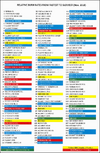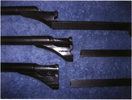You can damage an M1 with a dirty or improperly made BFA and blanks. A ported plug is insurance if you are going to shoot a lot and is cheaper than a new operating rod.
In early 2009 U.S. Army Armament Research Development and Engineering Center, Picatinny Arsenal, NJ investigated several failures with the Caliber .30 M1 Garand rifle firing M1909 blanks. Testing was the result of numerous complaints from veteran's groups regarding weapons stoppages, feeding problems, damaged weapons, and injury during ceremonies.
Now, you may be wondering how does firing a blank cartridge in a M1 manage to hurt it? Read and be amazed.
First off LCAAP redesigned the M1909 Blank cartridge back in 1999 which changed the mouth closure to a rosette crimp and expanded the acceptable propellants, as the original specified propellant was discontinued. And while LCAAP was the primary source for M1909 ammunition, one civilian firm was contracted to help meet demand. Since that redesign, there were an increasing number of problems reported.
In February 2009 there were a number of failures attributable to the blank cartridges reported from a Veteran’s organization. The reported failures were a ruptured blank firing adapter (BFA), two fractured operating rods, a firing pin, a cracked receiver, and most seriously, a broken receiver (601007) that cut that deeply cut the face of the shooter. Needless to say, all of these occurred with a BFA installed.
Figure 1. Broken Operating Rods
Figure 2. Fracture Firing Pins
Figure 3. Failed Receiver, Top
Figure 4. Failed Receiver, Bottom
So, why?
Obviously, the primary suspect was the propellant, so two test weapons were assembled. The first was a standard Universal receiver with a EPVAT barrel installed. This had two pressure transducers installed one at the case mouth and where the port is located on the M1. The second was a standard M1 Garand (inspected and all parts found within specification) with a pressure transducer installed in place of the Gas Cylinder Lock Screw (P/N 7310079). A high speed camera was used to measure the bolt velocity.
Three types of ammunition were tested for chamber and port pressure (cylinder pressure in the M1), rounds from one lot of LCAAP produced M1909 blanks, rounds from the commercial lot of M1909 blanks, and Federal GMM 168 gr as a baseline.
Because blank cartridges have so little propellant, it was important to measure pressures and velocities at various angles, blanks were fired at vertical, barrel up (+90), vertical barrel down (-90), horizontal (0), and 45 degrees up, as it would be fired in a ceremony (+45)
Eight rounds of FGMM were fired as a baseline followed by 64 rounds of each blank lots in each position were fired through the M1 (512 total). And, 30 round of each blank lot were fired through the EPVAT barrel (240 total).
Horizontal firing:
EPVAT chamber pressure results were largely as expected, the FGMM ran around 50,000 to 55,000 psi, the LCAAP blank cartridges ran around 2,500 psi, and the commercial blanks around 5,500 psi. Port pressures for the Blanks mirrored the chamber pressures being 3,000 and 5,500 psi respectively for LCAAP and commercial. The FGMM port pressures were 8,600 to 8,700 psi.
Off Horizontal firing (Blanks only).
At all angles the port pressure increased dramatically. LCAAP blanks about doubled, and the commercial showed about a 50% increase. The increase was largest when at -90. Naturally, the cylinder pressures mirrored the port pressures running in the 2,000 to 2,500 psi range. This was somewhat puzzling until it was discovered that the initial pressure rise from the primer tended to blow the propellant out of the cartridge case and down the barrel. Some unburn propellant would collect at the BFA orifice and then burn causing a small pressure bubble at the muzzle.
Bolt velocity:
Most alarming was the bolt velocity.
Figure 5. Bolt velocity vs Displacement
Because blank ammunition has no bullet to accelerate, the pressure rise in the barrel is faster and more uniform, the length of time the gas port in pressurized is longer, and while the average cylinder pressure of the blanks is only a few hundred psi off the FGMM, the average cylinder pressure is higher imparting more work to the system.
The M1 Garand was inspected after all testing was complete. After only 512 of these blanks, the receiver had two cracks on the heel, and excessive wear on the operating rod and receiver track.
The report concludes by stating a BFA should have an orifice of 0.172 inch and try to ensure the propellant is seated at the rear of the cartridge case. Also, noted was the operating rod spring should be within specification.
One more thing about the bolt velocity. The blank cartridges give a bolt velocity of 33 to 35 fps at impact with the rear of the receiver, the FGMM bolt velocity is just around 16 fps (which is a tad higher than with M2 ball). It doesn't take very much energy to increase the bolt velocity dramatically.






